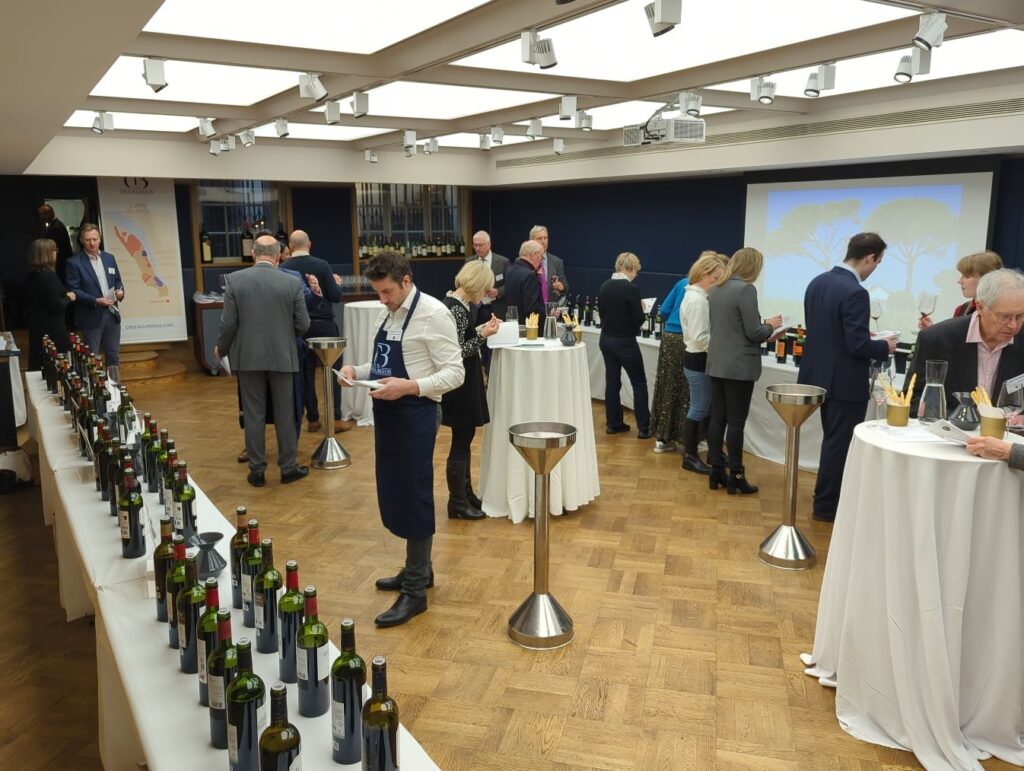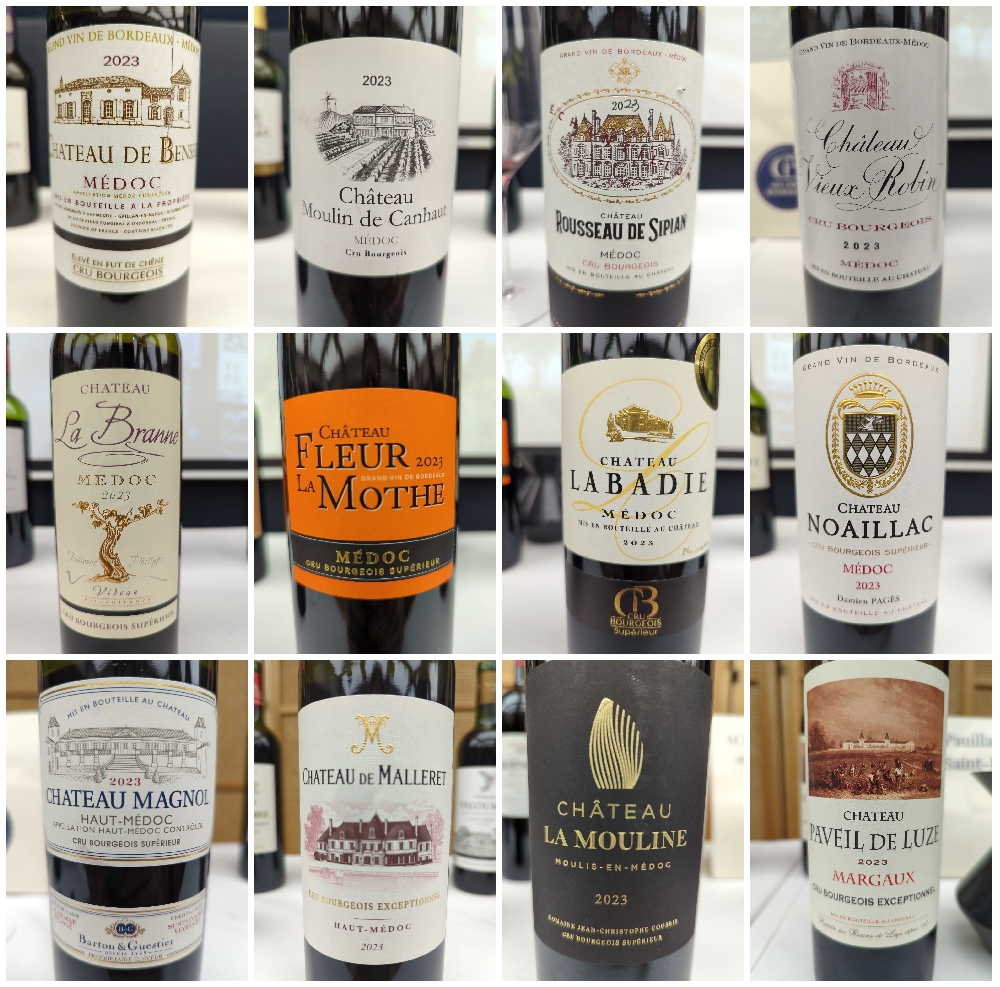
In November 2025 I was invited to Les Crus Bourgeois 2023 tasting in London, an event that brought together wines from the Médoc. Les Crus Bourgeois is a long-standing quality classification for estates not included in the famous Bordeaux 1855 ranking. First established in 1932, it highlights producers whose wines meet demanding standards, with blind tastings and estate inspections ensuring both quality and consistency. I have written a separate article that explores the system in greater depth, including the tiers and the châteaux involved.
This tasting was the first UK trade showing of the 2025 Classification, unveiled the previous February. It presented 60 wines from the 2023 vintage, spanning 27 Cru Bourgeois, 22 Cru Bourgeois Supérieur and 11 Cru Bourgeois Exceptionnel. Most offered layers of dark fruit, from cassis to blackberry and cherry, some woven with touches of violets, leather and smoke.
I found that the general standard was such that almost any of the wines would have shone in the tastings I usually attend. Even so, a handful showed a character or nuance that set them apart, and it was these distinctive bottles that stayed with me:

Chateau de Bensse 13.5%
70% Merlot, 30% Cabernet Sauvignon.
The name honours Nicolas de Bensse, a horseman in the Order of Saint Louis under Louis XIV. A deep blackberry aroma opens into subtle wood, spice and cocoa flavours. Tannins are softer than typically expected, making this an easy-drinking option.
Seeking UK importer
Château de Moulin Canhaut 13% £20 (est)
55% Merlot, 45% Cabernet Sauvignon.
Aromas of ripe black fruits with a vivid mix of blackcurrant and plum. Earthy blueberry flavours bring depth to the taste.
Seeking UK importer
Château Rousseau de Sipian 13%
71% Petit Verdot, 22% Cabernet Sauvignon, 7% Merlot.
There’s a smoky woodiness to the black fruit aroma and flavour. The tannins are on the softer side, making it smoother than you might expect.
Seeking UK importer
Château Vieux Robin 14% £15–£20 (est)
55% Cabernet Sauvignon, 40% Merlot, 3% Cabernet Franc, 2% Petit Verdot.
A floral aroma of violets leads into blackcurrant and dark berry flavours with a whisper of cedar. It begins softly but builds with medium tannins and complexity. This wine takes you on a bit of a journey.
Seeking UK importer
Chateau La Branne 13% £18 (est)
39.8% Cabernet Sauvignon, 37.4% Merlot, 22.8% Petit Verdot.
An intense aroma introduces a full blackcurrant flavour with hints of spice. One of the most balanced wines in the tasting, with low tannins for a smoother finish.
Cru Bourgeois Supérieur.
Seeking UK importer
Château Fleur La Mothe 14% £15–£20 (est)
45% Cabernet Sauvignon, 40% Merlot, 15% Petit Verdot.
Aromas are rich in blackcurrant. The flavour layers dark cherry, plum and oak together, with well-balanced tannins. Fuller and rounder than many others tasted.
Cru Bourgeois Supérieur.
Seeking UK importer
Château Labadie 13.8% £18 (est)
60% Merlot, 30% Cabernet Sauvignon, 10% Petit Verdot.
Dark in colour with an intense blackcurrant aroma. The flavour is among the most concentrated in black fruit, with smooth, integrated tannins giving structure.
Cru Bourgeois Supérieur.
Seeking UK importer
Château Noaillac 13% £15.50
55% Cabernet Sauvignon, 38% Merlot, 7% Petit Verdot.
Full of character, this wine delivers a very toasty and cedar-laced aroma with smokey and slightly earthy, savoury notes in the flavour. One of my favourites in the tasting and great value.
Cru Bourgeois Supérieur.
Imported by Thorman Hunt
Château Magnol 13% £25.90
48% Cabernet Sauvignon, 46% Merlot, 4% Cabernet Franc, 2% Petit Verdot.
Deep ruby in colour with a bold blackcurrant aroma. This has the deepest and most intense flavour of the tasting, with medium tannins. Strong blackcurrant continues through the finish. The flavour might even be too much without food.
Cru Bourgeois Supérieur.
Imported by Kingsland Drinks
Chateau de Malleret 13.5% £27.50 (est)
60% Cabernet Sauvignon, 34% Merlot, 6% Petit Verdot.
Dark with aromas of black fruits, floral hints and leather. A round texture supports medium tannins. This is among the most balanced wines here.
Cru Bourgeois Exceptionnel
Seeking UK importer
Château La Mouline 12.5% £20–£25 (est)
60% Merlot, 40% Cabernet Sauvignon.
Very dark in colour with a sleek, modern label. Blackberry fruit dominates the aroma, with a touch of oak. Flavours of blackberry and blackcurrant are balanced and long-lasting. One of the best in the tasting. Rounder than most, but, as with all these wines, not completely round.
Cru Bourgeois Supérieur.
Seeking UK importer
Château Paveil de Luze Margaux 13% £25–£30
90% Cabernet Sauvignon, 10% Merlot.
Slightly brown in colour with strong aromas of fruit, floral notes and oak. Redcurrant comes through clearly in the flavour. Lighter than expected but better for it and consequently more elegant.
Cru Bourgeois Exceptionnel.
Widely distributed
While a good number of the shown wines are already imported into the UK, I found myself drawn, though not exclusively, to those still seeking representation. It struck me that there may be an opportunity here for importers.
If I were to generally sum up Les Crus Bourgeois 2023, I would describe them as some of the more affordable yet distinctly flavoursome French wines available, often gaining from a spell in a decanter, a few additional years in bottle, or simply being enjoyed alongside food. Even so, the wines I have chosen here stand out because they are already approachable and enjoyable on their own, offering immediate pleasure without the need to wait.













